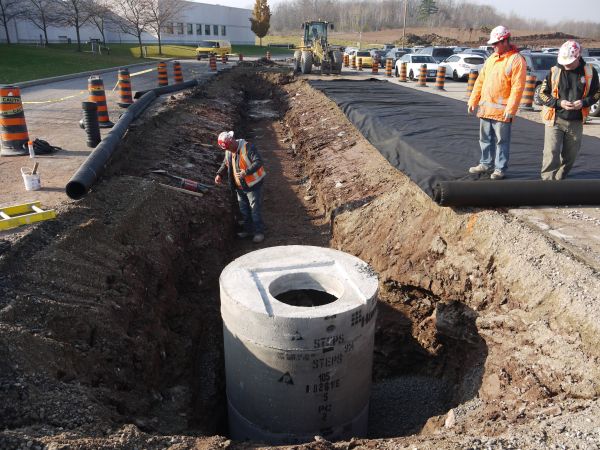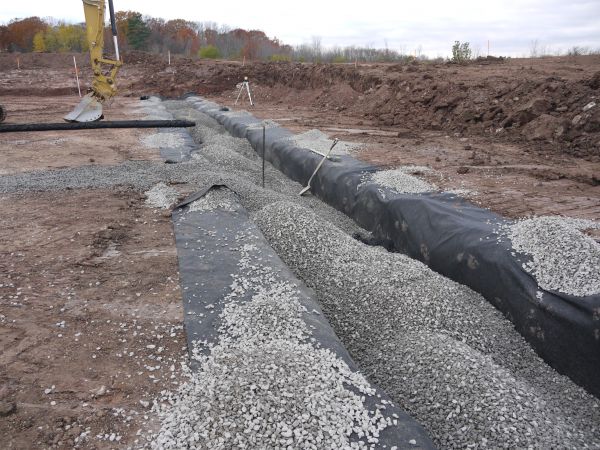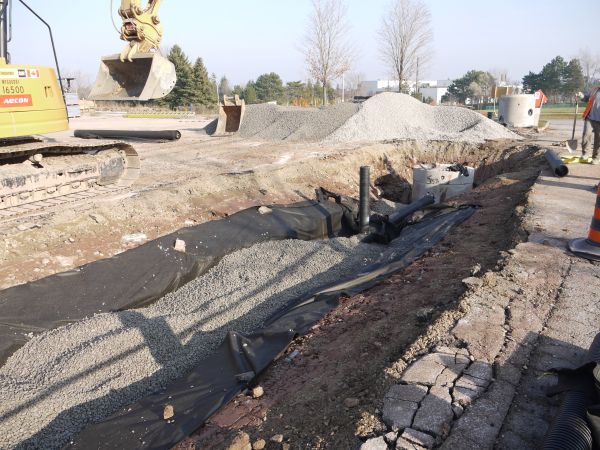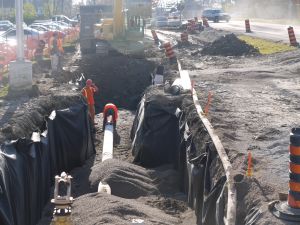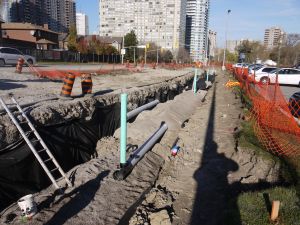Sub-surface components
The construction guidance in this section applies to all sub-surface and ground-level LID practices: bioretention gardens, bioswales, rain gardens, exfiltration trenches, enhanced swales, permeable pavements, infiltration trenches, infiltration chambers, and soakaways. In general, this section describes construction and inspection processes for below ground installed materials and infrastructure that are part of the LID practices noted above.
Overview[edit]
This section gives guidance for project managers, engineers, and contractors on the installation of sub-surface components of LID practices.
Geotextiles[edit]
Geotextiles are filter fabrics that can be installed to separate dissimilar soils and prevent the migration of materials. Geotextiles are recommended for installation at the bottom and side limits of the LID feature and should be implemented at the discretion of the engineer.
Construction Steps:
- Roll out fabric on the flattened sub-grade surface.
- Provide a minimum overlap of 300 mm between adjacent lengths of geotextile. If the manufacturer specifies a greater overlap, follow the manufacturer’s specification.
- Secure fabric in place with stakes along the edge of the sub-grade surface and where lengths of fabric overlap.
- Provide 500 mm of excess at the ends of each length of fabric. Fold excess materiel on top of the infiltration medium/choker course once installed.
- Provide cuts for trees and shrubs where appropriate.
- Assess on-site conditions to ensure that the tensile, tear, and puncture strength ratings of the geotextile are suitable for expected structural loads (e.g. traffic). If not properly considered, geotextiles can be adversely impacted by loading from adjacent infrastructure uses.
Key Inspection Points:
- Geotextile is clean and free of damage.
- Geotextile delivered to the site matches the design specifications and is approved by the engineer prior to installation.
- Sufficient overlap is provided between lengths of fabric.
- Geotextiles have been applied as per the manufacturer’s guidelines.
- Structural considerations for geotextiles have been made when applied adjacent to infrastructure and the geotextile can handle expected structural loads.
- Class II geotextiles conform to OPSS 1860.
Mistakes to Avoid:
- Wrinkles in the fabric: Follow the manufacturer’s procedure for installation to ensure geotextiles lie smooth on sub-grade.
- Unnecessary application of geotextile: Mixing of media is negligible where structural loads are not expected, so geotextile does not need to be applied. Also, geotextiles should not be used where root growth is encouraged to penetrate different layers of media.
Underdrains[edit]
Underdrains are perforated pipes that collect subsurface water and convey water out of an LID facility once it reaches capacity. Their design is determined by the drainage requirements of the feature.
Construction Steps:
- Install the underdrain to grade with a consistent slope of 0.5% to 1.0%.
- Connect overflow risers with single-elbowed ‘y’ connections or 45° elbows.
- Situate maintenance risers where siltation is expected in drain lines (such as at junctions or where grade and direction changes occur), in accordance with the design drawings.
- Mark the locations of risers.
- Use video inspections to confirm that the interior of the underdrain remains free of debris after construction.
Key Inspection Points:
- Size, type, and material of the underdrain conforms to the design specifications.
- Underdrain is perforated prior to arrival on-site.
- Drain material is resistant to UV radiation and any chemicals in the soil and groundwater.
- Clean-outs are positioned correctly and spaced appropriately for the size of the underdrain.
- Any manual perforations are approved by the design or field engineer.
- Pipe grade matches design specifications.
- Tie-in locations to municipal sewers meet municipal specifications.
Mistakes to Avoid:
- Incorrect overflow risers – ensure single-elbowed ‘y’ connections or 45° elbows are used for overflow risers instead of ‘T’ connections.
- Incorrect drain size – confirm underdrain has an internal diameter greater than or equal to 200 mm to reduce freezing and allow cleaning and camera inspections.
- Potential for clogging – Remove sock from underdrain prior to installation or geofabric wrap. A choker course is recommended, instead, as field change.
For more information on the design of underdrains, such as materials and connections, see the page on underdrains linked above.
Impermeable liners[edit]
Impermeable liners: Installation
Overflows[edit]
Monitoring wells[edit]
Monitoring wells: Installation
Storage reservoir[edit]
Construction: storage reservoir
Permeable pavement sub-base and base course[edit]
Permeable pavement sub-base and base course
Trench, Chamber, and Perforated Pipe Installation[edit]
Trench, chamber, and perforated pipe: Installation
Stone choker layer[edit]
In LID facilities, a choker layer of ≥ 100 mm depth is recommended to prevent migration of finer filter media into the underlying storage reservoir aggregate. Similar to the storage reservoir material, this aggregate layer should be a washed 5 – 10 mm stone free from fines and debris. Installation of aggregate choker layer should not be done when frozen.
Follow the construction guidance shown above in the section Storage reservoir
For more guidance on materials specifications, refer to Aggregates, OPSS aggregates and (Ontario Provincial Standards, 2013) [1]
Curbing[edit]
Pretreatment and inlet[edit]
Construction: pretreatment and inlet
References[edit]
- ↑ Ontario Provincial Standards. 2013. OPSS.PROV.10101 Aggregates - Base, Subbase Select Subgrade, and Backfill Material. https://www.roadauthority.com/Standards/?id=a28fdfaf-3bf8-4679-81ca-4e44b2263cf8
